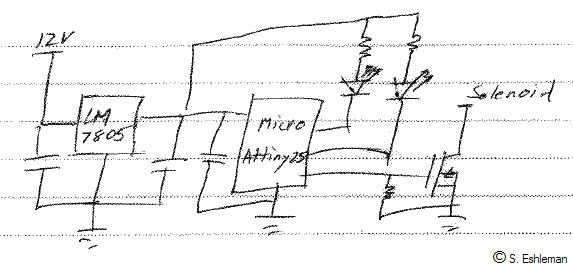So lets start with the switch. The switch obtains 12V power only when the key is in the on position.

The signal wire from the front switch then heads back under the rear seats... where the brains of the operation are.
I'll try to give you a quick synopsis of what goes on back there. First of all, the charging current is pulled off of the rear main 12V pole. The charging wire, 8 AWG (rated for 15' of wire 100 Amps non-steady max), runs from the 12V pole, and first hits a 100 Amp, resettable breaker. From there, the charging power travels to a 100 Amp constant-duty solenoid. From there, the 12V hot wire travels onto the auxiliary battery.
The signal wire, from the front switch, runs to the solenoid signal pole. Also getting 12V from this signal wire is my delay. This home-made digital delay waits 5 minutes before then connecting the ground side of the solenoid to ground through a FET rated for 1 amp continuous.
It's still a little messy, wire-wise... I'll clean it up with some wire-wraps eventually. But despite the messyness,... it works!

Close up of the digital delay (I used an old Dell power supply as the housing):

The power from the solenoid and a ground runs through a plug and into my rear cargo drawer enclosure, where I installed the aux battery. The rear battery has its own fuse box for the 750 Watt inverter and 12V lighter-plug (for future 12V cooler or fridge).
Picture when I finished it, not installed in the vehicle:

Picture installed in the vehicle, shows plug connection and location of emergency jump starter:

Close up of rear fuse box. Two 40 A fuses (the max I could find for a blade fuse) supply the inverter. The green wire sticking up is one I may use in the future... it's a potential signal wire running from the vehicle into the aux battery enclosure.

Close up of the battery and it's holding system I made:

So, overall, I keep the switch in the on-position. After the engine is started, the alternator charges the primary battery back from starting. 5 minutes after starting, the rear battery begins charging. So far, the system seems to work great!



 Pine Barrens Wheelin!
Pine Barrens Wheelin!



